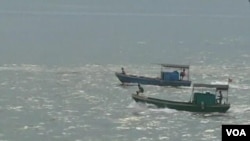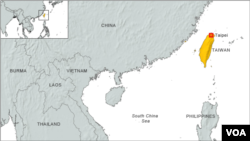TAIPEI —
Taiwan normally keeps quiet about its territorial claims in a sovereignty dispute in the South China Sea. But last week officials in Taipei announced plans to spend more than $100 million on a dock that could receive warships. Its plans call for upgrading an airstrip on the same island, which is the largest in the sea’s Spratly archipelago.Taiwan is moving to assert itself.
Taiwan’s intention to spend $112 million on the dock as part of a broader three-year infrastructure plan would raise its profile in the heavily contested South China Sea at a critical time as other claimants retrench. The dock and airstrip projects are set for Taiping Dao, the biggest island in the Spratly chain of largely uninhabited coral atolls.
China, the biggest claimant, has sparred increasingly with Vietnam and the Philippines over the ocean since early 2012 as it drills for undersea oil and natural gas. Experts say China is pushing for a secretive alliance with Taiwan, which faced its own spat with the Philippines this year. Brunei and Malaysia also claim parts of the sea which also is valued for fisheries and shipping lanes.
Lin Chong-pin, a strategic studies professor at Tamkang University in Taiwan, said Taiwan needs to step forward now after decades of being low key. “There’s a rising concern in the society that we have not paid enough attention to Taiping Dao. Before, I think we were more concerned about keeping a low profile or peace at sea,” stated Lin.
Lin adds that Taiwan President Ma Ying-jeou is paying more attention to his South China Sea claim in part because of pressure from Beijing to cooperate on territorial matters but he must also pay attention to Taipei’s informal alliance with the United States.
“It would have to do with Ma’s policy of standing between Beijing and Washington. Strengthening Taiping Dao would be a response to Beijing’s call for governing territory. On the other hand, Taiwan before would not like to displease the United States. The United States would like to see peace in that area,” said Lin.
China-Taiwan relations have been tense for decades, as Beijing claims sovereignty over Taiwan, despite the island's history of self-rule. In 2008 the two sides began cooperating on a range of issues to build mutual trust and bolster Taiwan’s economy. Analysts say China hopes to link up with Taiwan on international political disputes. But many Taiwanese people want the two sides to keep a distance as the United States' old Cold War foe China grows militarily.
Taiwan’s Spratly plans, which are now before the ruling party-dominated legislature, also follow a dispute in May with the Philippines. That month Manila’s coast guard shot to death a Taiwanese fisherman in overlapping waters, setting off a diplomatic row that ended only last month. Taiwan demanded that Manila enter fishery talks before it lifted punitive economic sanctions.
A year ago Taiwan’s coast guard carried out live-fire exercises on Taiping Dao. Experts say the other claimants are warily watching Taiwan’s moves, especially as diplomatically powerful China bars it from joining multilateral talks on keeping peace.
Taiwanese officials say the large dock would be completed by 2016 and may be part of a bigger transportation infrastructure plan for the island.
Taiwan’s intention to spend $112 million on the dock as part of a broader three-year infrastructure plan would raise its profile in the heavily contested South China Sea at a critical time as other claimants retrench. The dock and airstrip projects are set for Taiping Dao, the biggest island in the Spratly chain of largely uninhabited coral atolls.
China, the biggest claimant, has sparred increasingly with Vietnam and the Philippines over the ocean since early 2012 as it drills for undersea oil and natural gas. Experts say China is pushing for a secretive alliance with Taiwan, which faced its own spat with the Philippines this year. Brunei and Malaysia also claim parts of the sea which also is valued for fisheries and shipping lanes.
Lin Chong-pin, a strategic studies professor at Tamkang University in Taiwan, said Taiwan needs to step forward now after decades of being low key. “There’s a rising concern in the society that we have not paid enough attention to Taiping Dao. Before, I think we were more concerned about keeping a low profile or peace at sea,” stated Lin.
Lin adds that Taiwan President Ma Ying-jeou is paying more attention to his South China Sea claim in part because of pressure from Beijing to cooperate on territorial matters but he must also pay attention to Taipei’s informal alliance with the United States.
“It would have to do with Ma’s policy of standing between Beijing and Washington. Strengthening Taiping Dao would be a response to Beijing’s call for governing territory. On the other hand, Taiwan before would not like to displease the United States. The United States would like to see peace in that area,” said Lin.
China-Taiwan relations have been tense for decades, as Beijing claims sovereignty over Taiwan, despite the island's history of self-rule. In 2008 the two sides began cooperating on a range of issues to build mutual trust and bolster Taiwan’s economy. Analysts say China hopes to link up with Taiwan on international political disputes. But many Taiwanese people want the two sides to keep a distance as the United States' old Cold War foe China grows militarily.
Taiwan’s Spratly plans, which are now before the ruling party-dominated legislature, also follow a dispute in May with the Philippines. That month Manila’s coast guard shot to death a Taiwanese fisherman in overlapping waters, setting off a diplomatic row that ended only last month. Taiwan demanded that Manila enter fishery talks before it lifted punitive economic sanctions.
A year ago Taiwan’s coast guard carried out live-fire exercises on Taiping Dao. Experts say the other claimants are warily watching Taiwan’s moves, especially as diplomatically powerful China bars it from joining multilateral talks on keeping peace.
Taiwanese officials say the large dock would be completed by 2016 and may be part of a bigger transportation infrastructure plan for the island.

